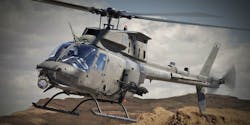U.S. Army flies Kiowa Warrior helicopter with modern avionics upgrades
REDSTONE ARSENAL, Ala., 30 April 2013. The U.S. Army, serving in the role of system integrator for the Cockpit and Sensor Upgrade Program (CASUP), achieved the first flight of the OH-58F Kiowa Warrior helicopter with upgraded avionics.
The OH-58F KW first flight marks the first time in Army aviation that the Army, rather than an industry manufacturer, has assumed the role of system integrator overseeing development, integration, and production.
CASUP brings the first KW helicopter designation change since 1990, as well as updates 1980’s equipment with the most current technology available, says a representative. The CASUP platform is intended to meet the Army’s armed scout requirement through fiscal year 2025.
“The OH-58 Kiowa Warrior is a phenomenal aircraft and continues to prove itself as an indispensible armed scout asset for our ground commanders,” says Maj. Gen. William “Tim” Crosby, Program Executive Officer for Army Aviation. The avionics upgrades provide soldiers with “the current capabilities they need to win in the battlefield,” he says.
With the Army as system integrator, the government will own many of the data rights necessary to foster full and open competition for production. “This approach to development, integration, and production keeps the government and contracted engineer developers working directly with military and government program management, allowing significant cost savings for the American taxpayers,” according to a spokesperson. “By the Army taking on the role as system integrator, the Army saves more than $37 million during the research, development, and test and evaluation phase, and more than $551 million during the procurement/production phase.”
“Controlling the design allows us to rapidly field mature technologies to support the Soldiers who depend on the Kiowa Warrior,” explains Col. Robert Grigsby, Armed Scout Helicopter Project Manager.
The F-model Kiowa Warrior capitalizes on non-developmental items and systems fielded on other aviation platforms. Among those items and systems are the advanced nose-mounted sensor, improved cockpit control hardware and software for enhanced situational awareness, three full-color multifunction displays, a dual-redundant digital engine controller for enhanced engine safety, digital inter-cockpit communications, digital HELLFIRE future upgrades, Aircraft Survivability Equipment (ASE) upgrades, and a redesigned aircraft wiring harness.
CASUP Product Manager Lt. Col. Mathew Hannah describes: “We have also worked closely with Bell Helicopter, the OH-58D KW Original Equipment Manufacturer (OEM), to design and develop the structural modifications on the aircraft. The result of these combined efforts with our OEM and our defense industry partners, we have realized an approximate 160 pound weight reduction to the basic aircraft weight.”
“Ultimately, KW pilots and crew members will be able to perform their mission more effectively, more efficiently, and more safely,” adds Col. John Lynch, Training and Doctrine Capability Manager for the Reconnaissance Attack fleet. “The improvements in sensor performance provide the ability to detect, mark, and engage targets from greater standoff ranges, protecting the crew and aircraft while performing the mission of supporting ground troops.”
The OH-58 KW has flown continuously for 25 years and may be required to fly for another 20 years.
